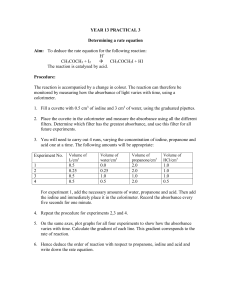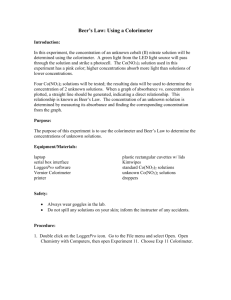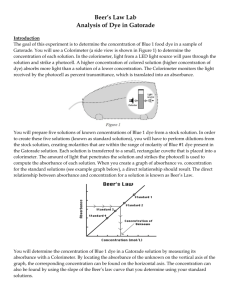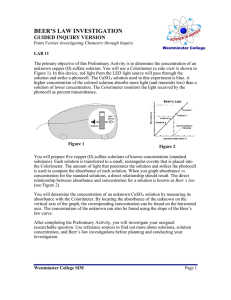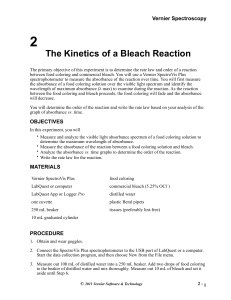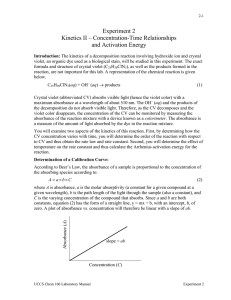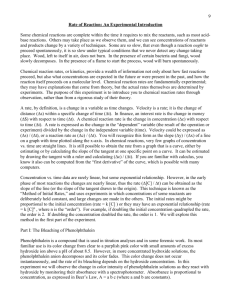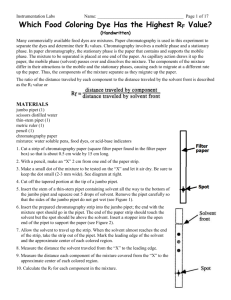The Kinetics of a Bleach Reaction
advertisement
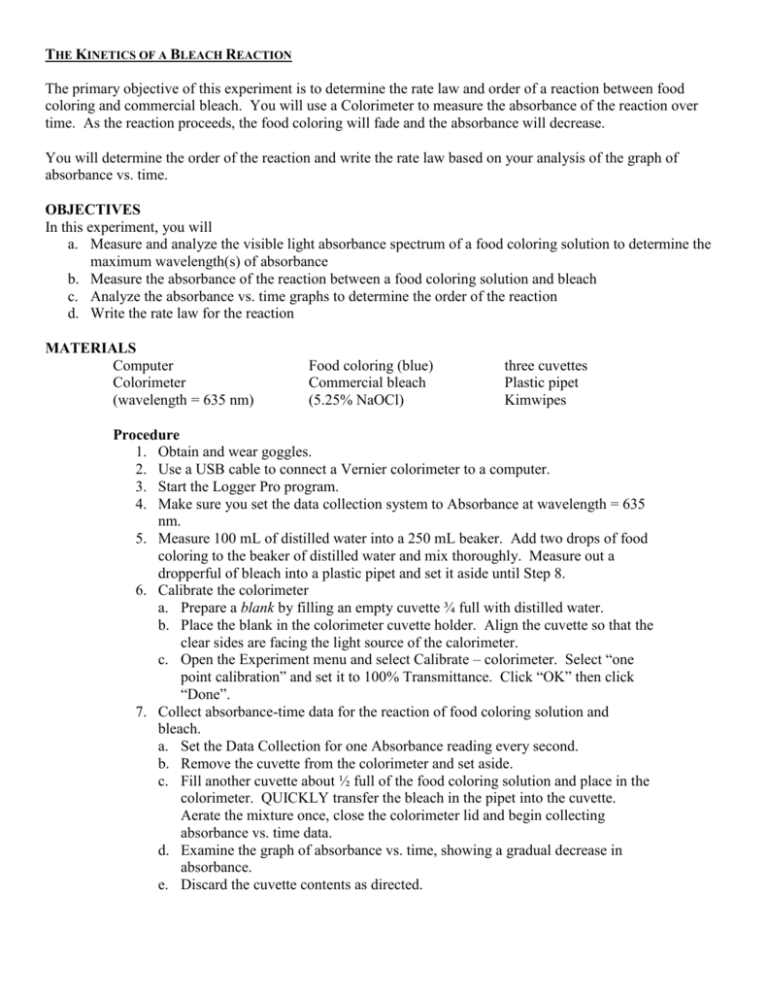
THE KINETICS OF A BLEACH REACTION The primary objective of this experiment is to determine the rate law and order of a reaction between food coloring and commercial bleach. You will use a Colorimeter to measure the absorbance of the reaction over time. As the reaction proceeds, the food coloring will fade and the absorbance will decrease. You will determine the order of the reaction and write the rate law based on your analysis of the graph of absorbance vs. time. OBJECTIVES In this experiment, you will a. Measure and analyze the visible light absorbance spectrum of a food coloring solution to determine the maximum wavelength(s) of absorbance b. Measure the absorbance of the reaction between a food coloring solution and bleach c. Analyze the absorbance vs. time graphs to determine the order of the reaction d. Write the rate law for the reaction MATERIALS Computer Colorimeter (wavelength = 635 nm) Food coloring (blue) Commercial bleach (5.25% NaOCl) three cuvettes Plastic pipet Kimwipes Procedure 1. Obtain and wear goggles. 2. Use a USB cable to connect a Vernier colorimeter to a computer. 3. Start the Logger Pro program. 4. Make sure you set the data collection system to Absorbance at wavelength = 635 nm. 5. Measure 100 mL of distilled water into a 250 mL beaker. Add two drops of food coloring to the beaker of distilled water and mix thoroughly. Measure out a dropperful of bleach into a plastic pipet and set it aside until Step 8. 6. Calibrate the colorimeter a. Prepare a blank by filling an empty cuvette ¾ full with distilled water. b. Place the blank in the colorimeter cuvette holder. Align the cuvette so that the clear sides are facing the light source of the calorimeter. c. Open the Experiment menu and select Calibrate – colorimeter. Select “one point calibration” and set it to 100% Transmittance. Click “OK” then click “Done”. 7. Collect absorbance-time data for the reaction of food coloring solution and bleach. a. Set the Data Collection for one Absorbance reading every second. b. Remove the cuvette from the colorimeter and set aside. c. Fill another cuvette about ½ full of the food coloring solution and place in the colorimeter. QUICKLY transfer the bleach in the pipet into the cuvette. Aerate the mixture once, close the colorimeter lid and begin collecting absorbance vs. time data. d. Examine the graph of absorbance vs. time, showing a gradual decrease in absorbance. e. Discard the cuvette contents as directed. Data Analysis 1. Use your results to determine the order of the reaction. Consider the bleach to be in excess. 2. Use the format: rate = k[FC]x to write a rate law for the reaction. [FC] denotes the molar concentration of the food colored solution. Substitute the appropriate digit for the value of x in the rate law. 3. Draw a sketch of the graph of Absorbance vs. time. Explain how you can determine the initial rate of the reaction from this graph. 4. From the graph of Absorbance vs. time, calculate the average rate during the first ten seconds of the reaction. 5. Determine the half-life of the reaction using the graph and using the equation for half-life. (How many seconds passed before the food coloring concentration decreased by half?) Extension Questions 1. The first-order decomposition of a colored chemical species, X, into colorless products is monitered with a spectrophotometer by measuring changes in absorbance over time. Species X has a molar absorptivity constant of 5.00103 cm–1M–1 and the pathlength of the cuvette containing the reaction mixture is 1.00 cm. The data from the experiment are given in the table below. [X] (M) Absorbance Time (min) ? 0.600 0.0 4.0010–5 0.200 35.0 3.0010–5 0.150 44.2 1.5010–5 0.075 ? (a) Calculate the initial concentration of the unknown species. (b) Calculate the rate constant for the first order reaction using the values given for concentration and time. Include units with your answers. (c) Calculate the minutes it takes for the absorbance to drop from 0.600 to 0.075. (d) Calculate the half-life of the reaction. Include units with your answer. (e) Experiments were performed to determine the value of the rate constant for this reaction at various temperatures. Data from these experiments were used to produce the graph below, where T is temperature. This graph can be used to determine Ea, the activation energy. (i) Label the vertical axis of the graph (ii) Explain how to calculate the activation energy from this graph. 2. Answer the following questions regarding the kinetics of chemical reactions. (a) The diagram below shows the energy pathway for the reaction O3 + NO NO2 + O2. Clearly label the following directly on the diagram. (i) The activation energy (Ea) for the forward reaction (ii) The enthalpy change (H) for the reaction (b) The reaction 2 N2O5 4 NO2 + O2 is first order with respect to N2O5. (i) Using the axes at right, complete the graph that represents the change in [N2O5] over time as the reaction proceeds. (ii) Describe how the graph in (i) could be used to find the reaction rate at a given time, t. (iii) Considering the rate law and the graph in (i), Initial describe how the value of the rate constant, k, [N2O3 ]• could be determined. (iv) If more N2O5 were added to the reaction mixture at constant temperature, what would be the effect on the rate constant, k ? Explain. Time (c) Data for the chemical reaction 2A B + C were collected by measuring the concentration of A at 10-minute intervals for 80 minutes. The following graphs were generated from analysis of the data. Use the information in the graphs above to answer the following. (i) Write the rate-law expression for the reaction. Justify your answer. (ii) Describe how to determine the value of the rate constant for the reaction.

